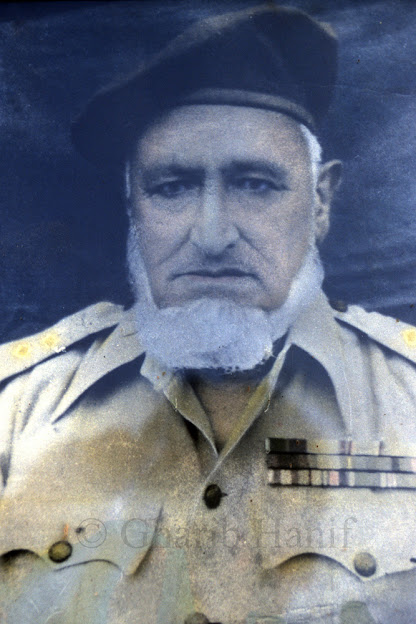Hast-o-Bood Part-31
Chapter IV
Historical background and brief overview of the
Historical background and brief overview of the
state of Jammu and Kashmir
Col Muhammad Mahmood Khan (Late)
Maharaja Gulab Singh Dogra repaired the strongest fort at Kotli in the area of Tharuchi at his discretion and established a strong military outpost here in view of its warlike importance, administrative grip of the government and to subdue the Mangral nation. It lasted till Pak and India. With the emergence of the state of Pakistan, the independence movement in the state of Jammu and Kashmir also gained momentum and the struggle to take off the shoes of Dogra slavery began in earnest. The Mangral Rajputs have been burning with national pride and revenge for the last century. Most of his men had been recruited into the British army and had been compromising for a long time under the pretext of keeping the blood warm. Most military pensioners lit torches under fire. Who knew that the fort of Tharochi which had been acquired by Sardar Sattar Muhammad Khan Mangral and his Jaila comrades by force of sword Sikhs. With the strategy and cunning of his shrewd and brave great-grandson Colonel Muhammad Mahmood Khan, the Dogra forces would be liberated in August 1947 and the fort and adjoining area along with the Sahansa valley of Mangral Rajputs by the bravery and determination of the Dogra rulers. The arm of the Azad Kashmir government will be made a swordsman.
Hear the details of this brief from Colonel Raja Muhammad Mahmood Khan himself, who narrated the attendance of the author at his service at his hill station, Dhok Gohra Bayaliyan (Mouza Khatkali) opposite Fort Tharochi.
Asked about his details, the Colonel said that he was born in 1892. Early education was limited to literacy. He joined the Government of India as a soldier in February 1908 as a nationalist soldier and as a protector of Rajput values. Passed Second English Army Course in Army. Due to his high discipline, hard work and good performance, he was made Subedar Major in 1937. Became a second lieutenant in 1941. In 1946, he was promoted to the rank of Captain and joined the First Frontier Force Regiment, the Infantry. High performance during his tenure was his hallmark. He retired from here in August 1946 as a captain and took the lead in Mouza Khatkali. At that time, the movement for annexation to Pakistan and liberation from Dogra tyranny was at its height in Jammu and Kashmir. Colonel Sahib's understanding of the matter soon made him realize the importance of national hierarchy and unification of Mangral ex-servicemen and military pensioners to work under one organization. He convened a meeting in Mangrala and addressed a public meeting to inform the audience about the usefulness of forming regional military organizations. The movement soon took shape. Area-wise military companies were formed. Thus, in August 1947, the 10th Kotli Battalion came into being, which was unanimously made Colonel and Chief Colonel Raja Muhammad Mahmood Khan. The members of this battalion were responsible for carrying out defense operations in the form of separate platoon in their respective areas and assisting each other in times of need.
On learning of these military activities, Raja Hari Singh Dogra himself came to Kotli Mangral to inspect the situation on the spot. Colonel Muhammad Mahmood Khan was unanimously chosen by the ex-servicemen to talk to the Maharaja. Although Maharaja Hari Singh wished to limit his meeting with Colonel Sahib to Alik Salik only as a courtier, Colonel Sahib boldly and unabashedly told the Maharaja in a packed court that the Mangral nation had fully cooperated with the state government for the last century. But now it is their unanimous decision that the Maharaja should annex the state of Jammu and Kashmir to the state of Pakistan, otherwise the zealous nation will be forced to clash with the government of the time for its independence. It may be recalled that the Maharaja was in power at that time and a man of iron like Colonel Muhammad Mahmood Khan was needed to speak the truth before an oppressive ruler.
If he is a disbeliever, he trusts in the sword
If he is a believer, he could fight without a sword
If he is a believer, he could fight without a sword
Although Maharaja Hari Singh raised his eyebrows at the death of this man, he remained silent, realizing the military strength, influence and timeliness of the Colonel and returned to Srinagar after the meeting.
The war of independence started from Qila-e-Adin under the leadership of Khushal Khan Sati Rajput and in Pakpattan under the leadership of Raja Sakhi Dalir Khan Mangral. Thus, Mujahidin captured both the places.
On the other hand, riots broke out in the area of Sahansa Valley and Fort Tharochi. Apart from the fort of Tharochi and the adjoining villages of Tharoch, the surrounding area was inhabited by the Mangral Rajput nation. The military organization was affiliated with Colonel Raja Muhammad Mahmood Khan.
In the Sahansa Valley, in the performance of Subedar Pensioner Barukhan Sudhan, the brave soldiers of the Mangaralan area and the Sadhan nation gritted the teeth of the enemy and continued the jihad against the Dogra army. The said Subedar was martyred during the same Jihad.
They made happy rituals, hunger and bloodshed
May God have mercy on the lovers of the Holy Land
May God have mercy on the lovers of the Holy Land
The soldiers of the area laid siege to the Dogra Sipah and tried to eliminate them, but the Muslim Colonel Hameed Khan of the Dogra army sought respite and with great skill drove the Dogra and Muslim "mixed" army out of here in the dark of night.
to be continued .....
Note: Blogger does not necessarily agree with the text of the book.



Comments
Post a Comment